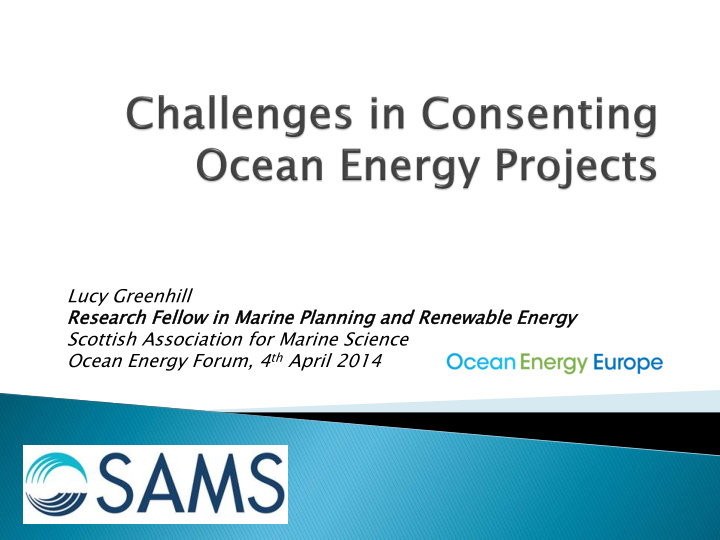



Lucy Greenhill Research rch Fellow ow in M Marine ne Planni ning ng and Rene newa wable le Energy rgy Scottish Association for Marine Science Ocean Energy Forum, 4 th April 2014
1. 1. INTRODUC RODUCTION TION 2. 2. CURRENT RENT PRIORITI RITIES ES 3. 3. OUTSTAN STANDING ING CHALLENG LENGES 4. 4. STRATEG TEGIC C SOLUTI UTIONS ONS 5. 5. SUMMARY RY
1. IN INTRO TRODUCT UCTION ION We are ‘talking the talk’…. …but can we ‘walk the walk’? Draft Plan Options for Renewable Energy in Scotland, Scottish Government, 2013
2. C CURREN RENT T PRIOR ORITI TIES ES Information gaps on impacts • well known. Wildlife Displacement Interference with habitat use & movements Emphasis on information • gathering for project consent application (EIA). Collision Risks Mammals • Fish • Birds Modelling Behaviour Encounter Rate, Evasion Device acoustic Habitat Modification footprints Sediment redistribution, Device & background: Burying Prediction, measurement & mitigation
2. C CURREN RENT T PRIOR ORITI TIES ES (cont nt.) Numerous strategic initiatives • are looking at industry impacts (to birds, fish, mammals, etc.) Advances in scientific • understanding e.g. models to predict collision risk “Will there be an impact?” • “How big will the impact be?" But why is • decision making at projects still complic omplicat ated ed, expen ensiv sive e and http://www.scotland.gov.uk/Publications/2013/09/5811 unc ncerta tain in?
3. O OUTST TSTANDI NDING NG CHALLENG LENGES ES Major problem is that there are no precedents – huge uncertainty. • Results in increasingly scientifically complex modelling to make • predictions in EIAs. Reliance on ‘expert judgement’ and subjectivity. • This leads to challenges in consenting according to conservation • policy with high requirement for certainty (e.g. Habitats Directive – “no reasonable scientific doubt.”). Harbour Seal (SAMS) Europ opea ean n Prot otec ecte ted Spec ecie ies Harbour Porpoise (SAMS)
3. O OUTST TSTANDI NDING NG CHALLENG LENGES ES (cont. t.) Consent application / EIA – very scientific, lots of investment, The Consenting Process – new information. ‘square peg, round hole’? Need to balance investment here… Legislative Framework (e.g. Habitats Regulations) – policy instruments, limited scientific input, low investment.
3. O OUTST TSTANDI NDING NG CHALLENG LENGES ES (cont. t.) More effort is needed to address the difficult questions such as: What is an ‘acceptable’ level of environmental change? • How will the environment change without development? • What is the baseline ? How do we ensure “Site Integrity” / “Favourable • Conservation Status”? How is uncertainty and expert judgement considered? • Industry will ‘tick the box’ but they need to know what to aim at…
4. S STRATE RATEGIC GIC SOLUTIO UTIONS NS We need to look forward at the problems in the decision • making process. Consenting risks need to be considered in greater detail • during strategic and sectoral planning exercises (including SEA). National level actions into addressing problems in consenting • frameworks would take pressure off individual projects. Look at the potential for marine planning to balance • environmental objectives and renewable energy plans. Might not need more spending, just spending on the right • questions.
5. S SUMMA MARY RY Lots of money is being spent on predicting project-specific • impacts. This isn’t enough to make consenting more straightforward. • What is acceptable? We need effort into defining the • consenting framework to maintain investor confidence. Strategic approaches and marine planning will be essential • and useful in managing risks from industry activities in a more cost-effective way. Pelamis Wave Power OpenHydro Tidal Turbine
To discuss…! Thank you for listening. Lucy.greenhill@sams.ac.uk www.sams.ac.uk
Recommend
More recommend